Strategic Management Report: Analyzing A2B Company's Strategies
VerifiedAdded on 2020/07/23
|34
|12246
|53
Report
AI Summary
This report delves into the strategic management of A2B Company, examining the core concepts and processes involved. It begins by defining strategy and outlining the elements of the strategic management process, including situation analysis, goal-setting, analysis, strategy formulation, implementation, environmental analysis, and evaluation. The report then critically analyzes the roles of values, vision, and mission statements in guiding organizational direction. Different approaches to strategy formulation are explored, along with the influence of the external environment. The analysis further differentiates between the general, competitive, and internal environments of organizations, highlighting the tools used for their analysis. The report also examines the role of organizational strategy in achieving competitive advantage and the impact of markets on strategy formulation. Furthermore, it discusses how organizational processes support strategy implementation and evaluates the place of strategic control and reward systems. Finally, the report assesses different approaches to strategic change and analyzes the role of administrative managers in facilitating strategy implementation.
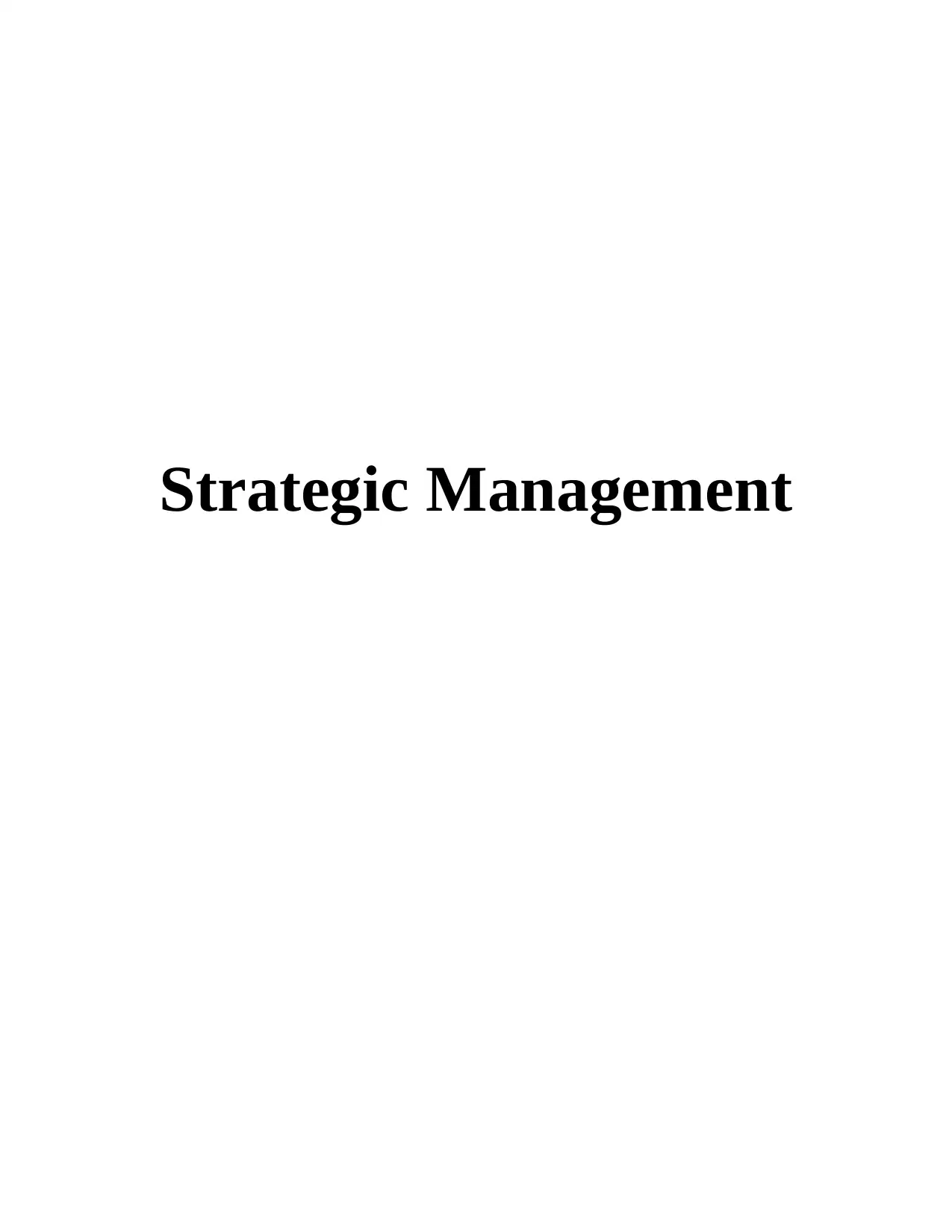
Strategic Management
Paraphrase This Document
Need a fresh take? Get an instant paraphrase of this document with our AI Paraphraser
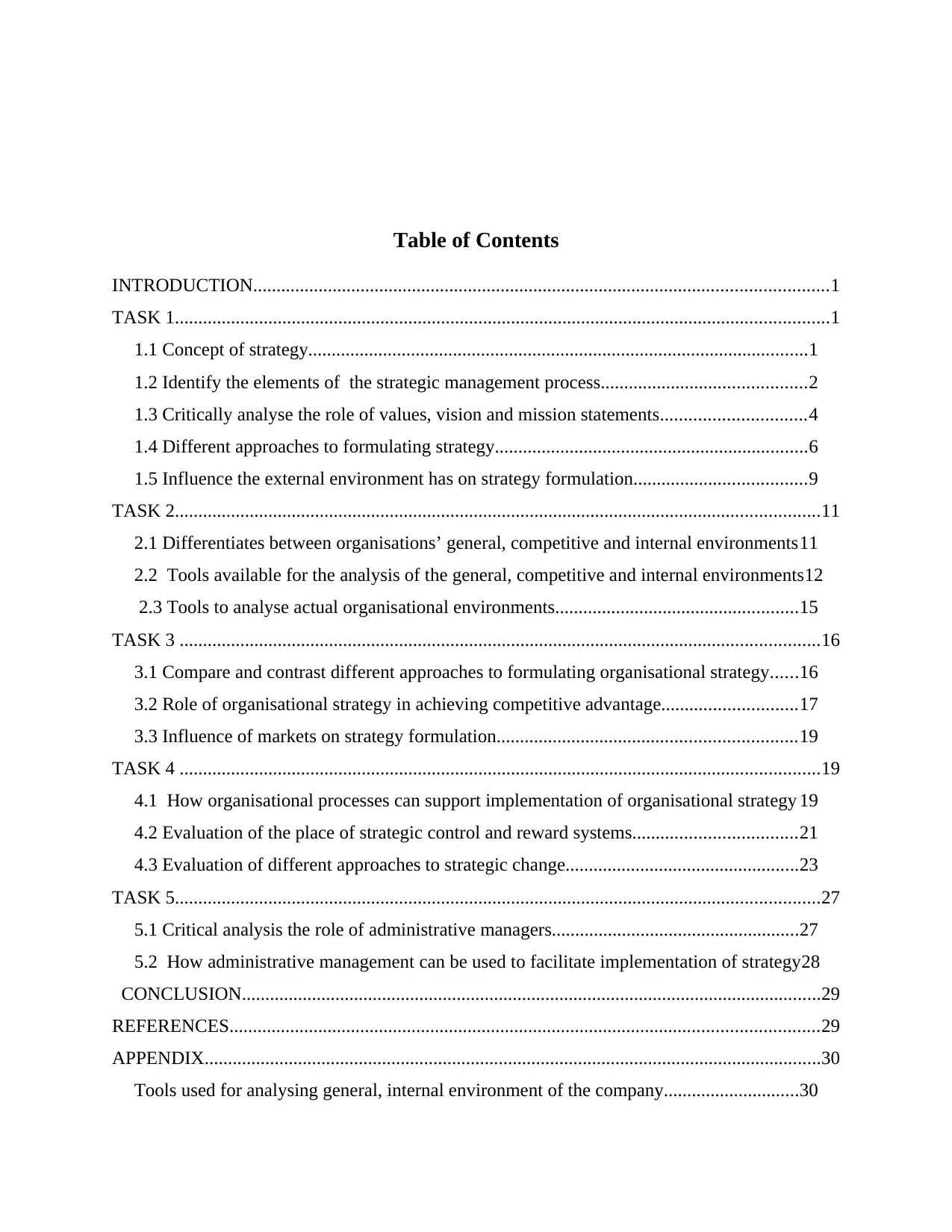
Table of Contents
INTRODUCTION...........................................................................................................................1
TASK 1............................................................................................................................................1
1.1 Concept of strategy...........................................................................................................1
1.2 Identify the elements of the strategic management process............................................2
1.3 Critically analyse the role of values, vision and mission statements...............................4
1.4 Different approaches to formulating strategy...................................................................6
1.5 Influence the external environment has on strategy formulation.....................................9
TASK 2..........................................................................................................................................11
2.1 Differentiates between organisations’ general, competitive and internal environments11
2.2 Tools available for the analysis of the general, competitive and internal environments12
2.3 Tools to analyse actual organisational environments....................................................15
TASK 3 .........................................................................................................................................16
3.1 Compare and contrast different approaches to formulating organisational strategy......16
3.2 Role of organisational strategy in achieving competitive advantage.............................17
3.3 Influence of markets on strategy formulation................................................................19
TASK 4 .........................................................................................................................................19
4.1 How organisational processes can support implementation of organisational strategy 19
4.2 Evaluation of the place of strategic control and reward systems...................................21
4.3 Evaluation of different approaches to strategic change..................................................23
TASK 5..........................................................................................................................................27
5.1 Critical analysis the role of administrative managers.....................................................27
5.2 How administrative management can be used to facilitate implementation of strategy28
CONCLUSION............................................................................................................................29
REFERENCES..............................................................................................................................29
APPENDIX....................................................................................................................................30
Tools used for analysing general, internal environment of the company.............................30
INTRODUCTION...........................................................................................................................1
TASK 1............................................................................................................................................1
1.1 Concept of strategy...........................................................................................................1
1.2 Identify the elements of the strategic management process............................................2
1.3 Critically analyse the role of values, vision and mission statements...............................4
1.4 Different approaches to formulating strategy...................................................................6
1.5 Influence the external environment has on strategy formulation.....................................9
TASK 2..........................................................................................................................................11
2.1 Differentiates between organisations’ general, competitive and internal environments11
2.2 Tools available for the analysis of the general, competitive and internal environments12
2.3 Tools to analyse actual organisational environments....................................................15
TASK 3 .........................................................................................................................................16
3.1 Compare and contrast different approaches to formulating organisational strategy......16
3.2 Role of organisational strategy in achieving competitive advantage.............................17
3.3 Influence of markets on strategy formulation................................................................19
TASK 4 .........................................................................................................................................19
4.1 How organisational processes can support implementation of organisational strategy 19
4.2 Evaluation of the place of strategic control and reward systems...................................21
4.3 Evaluation of different approaches to strategic change..................................................23
TASK 5..........................................................................................................................................27
5.1 Critical analysis the role of administrative managers.....................................................27
5.2 How administrative management can be used to facilitate implementation of strategy28
CONCLUSION............................................................................................................................29
REFERENCES..............................................................................................................................29
APPENDIX....................................................................................................................................30
Tools used for analysing general, internal environment of the company.............................30

⊘ This is a preview!⊘
Do you want full access?
Subscribe today to unlock all pages.

Trusted by 1+ million students worldwide
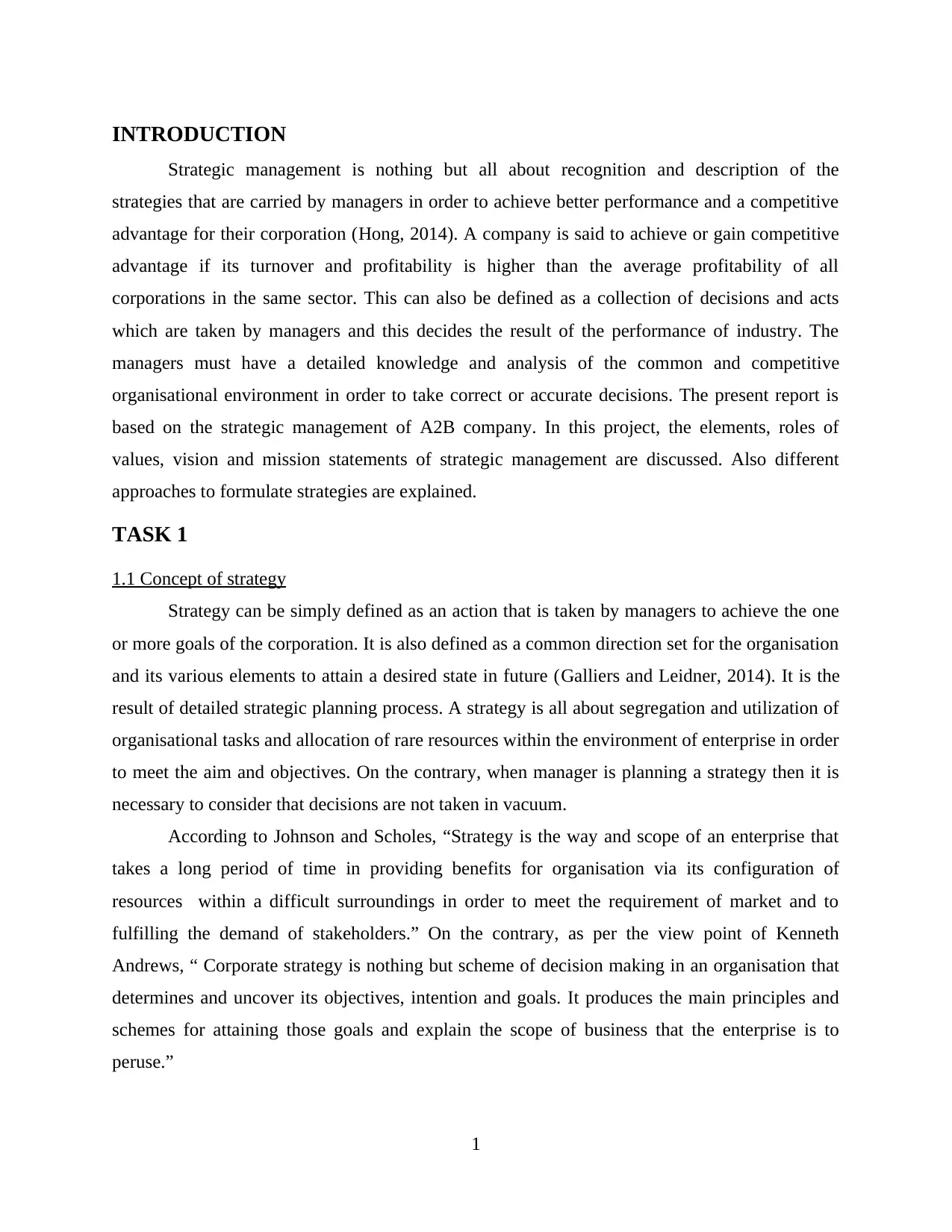
INTRODUCTION
Strategic management is nothing but all about recognition and description of the
strategies that are carried by managers in order to achieve better performance and a competitive
advantage for their corporation (Hong, 2014). A company is said to achieve or gain competitive
advantage if its turnover and profitability is higher than the average profitability of all
corporations in the same sector. This can also be defined as a collection of decisions and acts
which are taken by managers and this decides the result of the performance of industry. The
managers must have a detailed knowledge and analysis of the common and competitive
organisational environment in order to take correct or accurate decisions. The present report is
based on the strategic management of A2B company. In this project, the elements, roles of
values, vision and mission statements of strategic management are discussed. Also different
approaches to formulate strategies are explained.
TASK 1
1.1 Concept of strategy
Strategy can be simply defined as an action that is taken by managers to achieve the one
or more goals of the corporation. It is also defined as a common direction set for the organisation
and its various elements to attain a desired state in future (Galliers and Leidner, 2014). It is the
result of detailed strategic planning process. A strategy is all about segregation and utilization of
organisational tasks and allocation of rare resources within the environment of enterprise in order
to meet the aim and objectives. On the contrary, when manager is planning a strategy then it is
necessary to consider that decisions are not taken in vacuum.
According to Johnson and Scholes, “Strategy is the way and scope of an enterprise that
takes a long period of time in providing benefits for organisation via its configuration of
resources within a difficult surroundings in order to meet the requirement of market and to
fulfilling the demand of stakeholders.” On the contrary, as per the view point of Kenneth
Andrews, “ Corporate strategy is nothing but scheme of decision making in an organisation that
determines and uncover its objectives, intention and goals. It produces the main principles and
schemes for attaining those goals and explain the scope of business that the enterprise is to
peruse.”
1
Strategic management is nothing but all about recognition and description of the
strategies that are carried by managers in order to achieve better performance and a competitive
advantage for their corporation (Hong, 2014). A company is said to achieve or gain competitive
advantage if its turnover and profitability is higher than the average profitability of all
corporations in the same sector. This can also be defined as a collection of decisions and acts
which are taken by managers and this decides the result of the performance of industry. The
managers must have a detailed knowledge and analysis of the common and competitive
organisational environment in order to take correct or accurate decisions. The present report is
based on the strategic management of A2B company. In this project, the elements, roles of
values, vision and mission statements of strategic management are discussed. Also different
approaches to formulate strategies are explained.
TASK 1
1.1 Concept of strategy
Strategy can be simply defined as an action that is taken by managers to achieve the one
or more goals of the corporation. It is also defined as a common direction set for the organisation
and its various elements to attain a desired state in future (Galliers and Leidner, 2014). It is the
result of detailed strategic planning process. A strategy is all about segregation and utilization of
organisational tasks and allocation of rare resources within the environment of enterprise in order
to meet the aim and objectives. On the contrary, when manager is planning a strategy then it is
necessary to consider that decisions are not taken in vacuum.
According to Johnson and Scholes, “Strategy is the way and scope of an enterprise that
takes a long period of time in providing benefits for organisation via its configuration of
resources within a difficult surroundings in order to meet the requirement of market and to
fulfilling the demand of stakeholders.” On the contrary, as per the view point of Kenneth
Andrews, “ Corporate strategy is nothing but scheme of decision making in an organisation that
determines and uncover its objectives, intention and goals. It produces the main principles and
schemes for attaining those goals and explain the scope of business that the enterprise is to
peruse.”
1
Paraphrase This Document
Need a fresh take? Get an instant paraphrase of this document with our AI Paraphraser
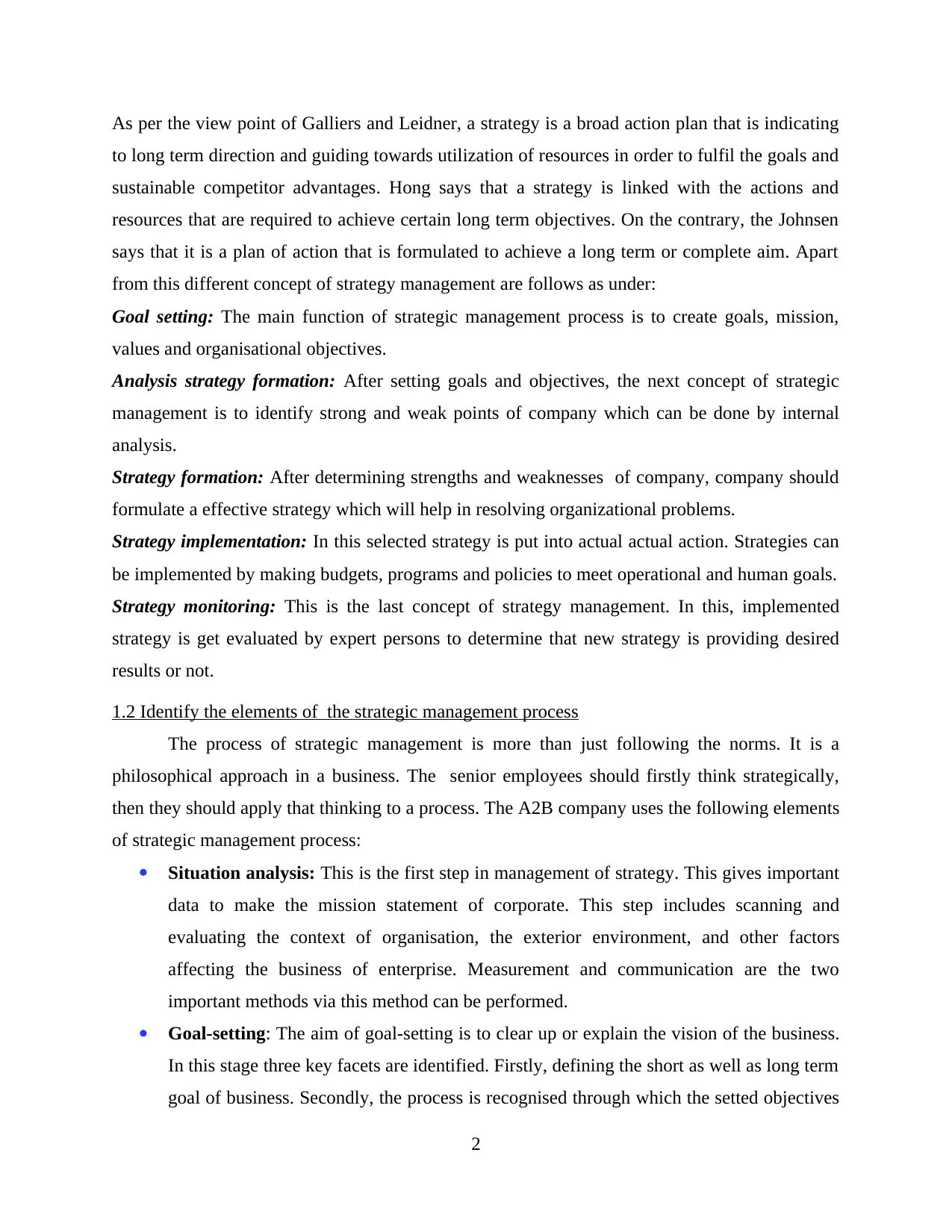
As per the view point of Galliers and Leidner, a strategy is a broad action plan that is indicating
to long term direction and guiding towards utilization of resources in order to fulfil the goals and
sustainable competitor advantages. Hong says that a strategy is linked with the actions and
resources that are required to achieve certain long term objectives. On the contrary, the Johnsen
says that it is a plan of action that is formulated to achieve a long term or complete aim. Apart
from this different concept of strategy management are follows as under:
Goal setting: The main function of strategic management process is to create goals, mission,
values and organisational objectives.
Analysis strategy formation: After setting goals and objectives, the next concept of strategic
management is to identify strong and weak points of company which can be done by internal
analysis.
Strategy formation: After determining strengths and weaknesses of company, company should
formulate a effective strategy which will help in resolving organizational problems.
Strategy implementation: In this selected strategy is put into actual actual action. Strategies can
be implemented by making budgets, programs and policies to meet operational and human goals.
Strategy monitoring: This is the last concept of strategy management. In this, implemented
strategy is get evaluated by expert persons to determine that new strategy is providing desired
results or not.
1.2 Identify the elements of the strategic management process
The process of strategic management is more than just following the norms. It is a
philosophical approach in a business. The senior employees should firstly think strategically,
then they should apply that thinking to a process. The A2B company uses the following elements
of strategic management process:
Situation analysis: This is the first step in management of strategy. This gives important
data to make the mission statement of corporate. This step includes scanning and
evaluating the context of organisation, the exterior environment, and other factors
affecting the business of enterprise. Measurement and communication are the two
important methods via this method can be performed.
Goal-setting: The aim of goal-setting is to clear up or explain the vision of the business.
In this stage three key facets are identified. Firstly, defining the short as well as long term
goal of business. Secondly, the process is recognised through which the setted objectives
2
to long term direction and guiding towards utilization of resources in order to fulfil the goals and
sustainable competitor advantages. Hong says that a strategy is linked with the actions and
resources that are required to achieve certain long term objectives. On the contrary, the Johnsen
says that it is a plan of action that is formulated to achieve a long term or complete aim. Apart
from this different concept of strategy management are follows as under:
Goal setting: The main function of strategic management process is to create goals, mission,
values and organisational objectives.
Analysis strategy formation: After setting goals and objectives, the next concept of strategic
management is to identify strong and weak points of company which can be done by internal
analysis.
Strategy formation: After determining strengths and weaknesses of company, company should
formulate a effective strategy which will help in resolving organizational problems.
Strategy implementation: In this selected strategy is put into actual actual action. Strategies can
be implemented by making budgets, programs and policies to meet operational and human goals.
Strategy monitoring: This is the last concept of strategy management. In this, implemented
strategy is get evaluated by expert persons to determine that new strategy is providing desired
results or not.
1.2 Identify the elements of the strategic management process
The process of strategic management is more than just following the norms. It is a
philosophical approach in a business. The senior employees should firstly think strategically,
then they should apply that thinking to a process. The A2B company uses the following elements
of strategic management process:
Situation analysis: This is the first step in management of strategy. This gives important
data to make the mission statement of corporate. This step includes scanning and
evaluating the context of organisation, the exterior environment, and other factors
affecting the business of enterprise. Measurement and communication are the two
important methods via this method can be performed.
Goal-setting: The aim of goal-setting is to clear up or explain the vision of the business.
In this stage three key facets are identified. Firstly, defining the short as well as long term
goal of business. Secondly, the process is recognised through which the setted objectives
2
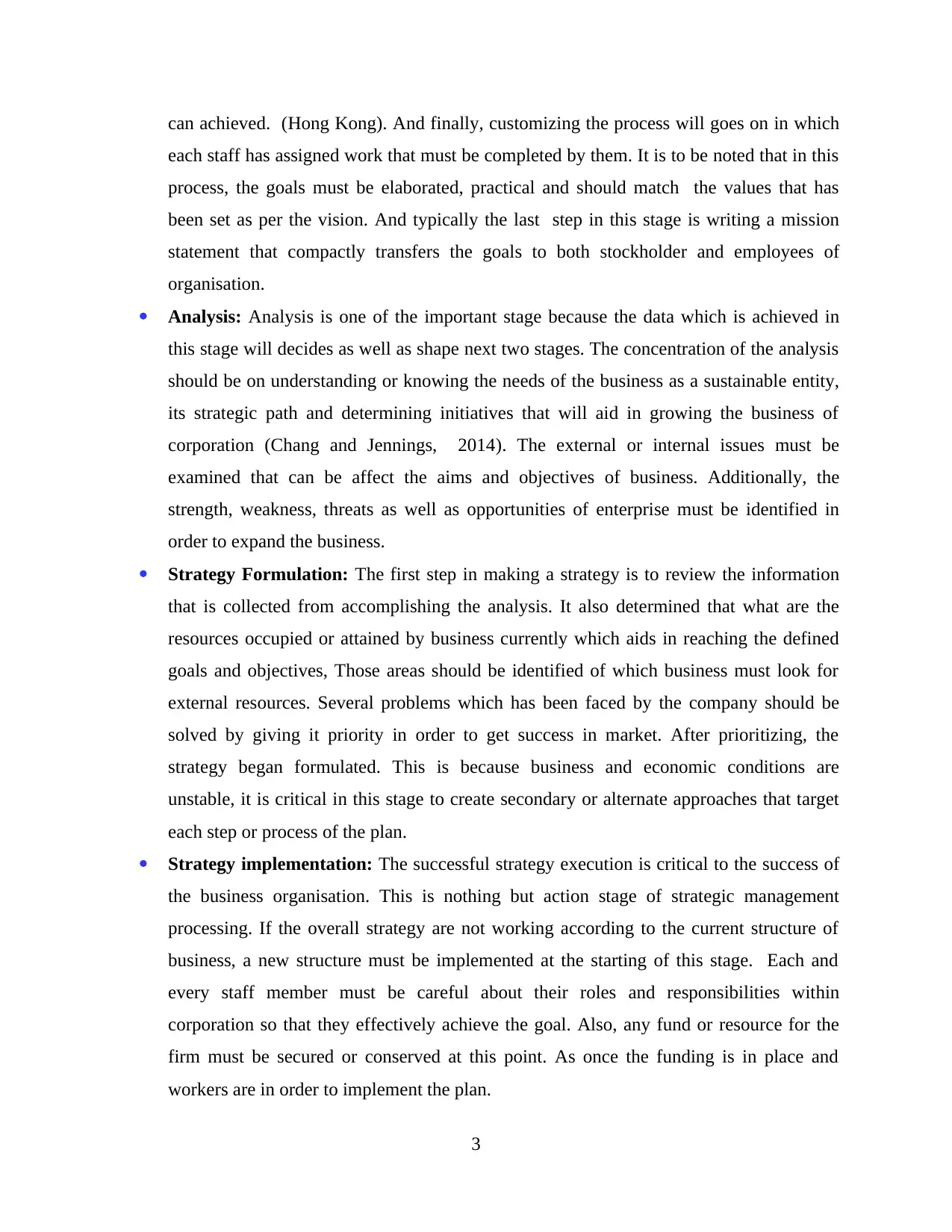
can achieved. (Hong Kong). And finally, customizing the process will goes on in which
each staff has assigned work that must be completed by them. It is to be noted that in this
process, the goals must be elaborated, practical and should match the values that has
been set as per the vision. And typically the last step in this stage is writing a mission
statement that compactly transfers the goals to both stockholder and employees of
organisation.
Analysis: Analysis is one of the important stage because the data which is achieved in
this stage will decides as well as shape next two stages. The concentration of the analysis
should be on understanding or knowing the needs of the business as a sustainable entity,
its strategic path and determining initiatives that will aid in growing the business of
corporation (Chang and Jennings, 2014). The external or internal issues must be
examined that can be affect the aims and objectives of business. Additionally, the
strength, weakness, threats as well as opportunities of enterprise must be identified in
order to expand the business.
Strategy Formulation: The first step in making a strategy is to review the information
that is collected from accomplishing the analysis. It also determined that what are the
resources occupied or attained by business currently which aids in reaching the defined
goals and objectives, Those areas should be identified of which business must look for
external resources. Several problems which has been faced by the company should be
solved by giving it priority in order to get success in market. After prioritizing, the
strategy began formulated. This is because business and economic conditions are
unstable, it is critical in this stage to create secondary or alternate approaches that target
each step or process of the plan.
Strategy implementation: The successful strategy execution is critical to the success of
the business organisation. This is nothing but action stage of strategic management
processing. If the overall strategy are not working according to the current structure of
business, a new structure must be implemented at the starting of this stage. Each and
every staff member must be careful about their roles and responsibilities within
corporation so that they effectively achieve the goal. Also, any fund or resource for the
firm must be secured or conserved at this point. As once the funding is in place and
workers are in order to implement the plan.
3
each staff has assigned work that must be completed by them. It is to be noted that in this
process, the goals must be elaborated, practical and should match the values that has
been set as per the vision. And typically the last step in this stage is writing a mission
statement that compactly transfers the goals to both stockholder and employees of
organisation.
Analysis: Analysis is one of the important stage because the data which is achieved in
this stage will decides as well as shape next two stages. The concentration of the analysis
should be on understanding or knowing the needs of the business as a sustainable entity,
its strategic path and determining initiatives that will aid in growing the business of
corporation (Chang and Jennings, 2014). The external or internal issues must be
examined that can be affect the aims and objectives of business. Additionally, the
strength, weakness, threats as well as opportunities of enterprise must be identified in
order to expand the business.
Strategy Formulation: The first step in making a strategy is to review the information
that is collected from accomplishing the analysis. It also determined that what are the
resources occupied or attained by business currently which aids in reaching the defined
goals and objectives, Those areas should be identified of which business must look for
external resources. Several problems which has been faced by the company should be
solved by giving it priority in order to get success in market. After prioritizing, the
strategy began formulated. This is because business and economic conditions are
unstable, it is critical in this stage to create secondary or alternate approaches that target
each step or process of the plan.
Strategy implementation: The successful strategy execution is critical to the success of
the business organisation. This is nothing but action stage of strategic management
processing. If the overall strategy are not working according to the current structure of
business, a new structure must be implemented at the starting of this stage. Each and
every staff member must be careful about their roles and responsibilities within
corporation so that they effectively achieve the goal. Also, any fund or resource for the
firm must be secured or conserved at this point. As once the funding is in place and
workers are in order to implement the plan.
3
⊘ This is a preview!⊘
Do you want full access?
Subscribe today to unlock all pages.

Trusted by 1+ million students worldwide
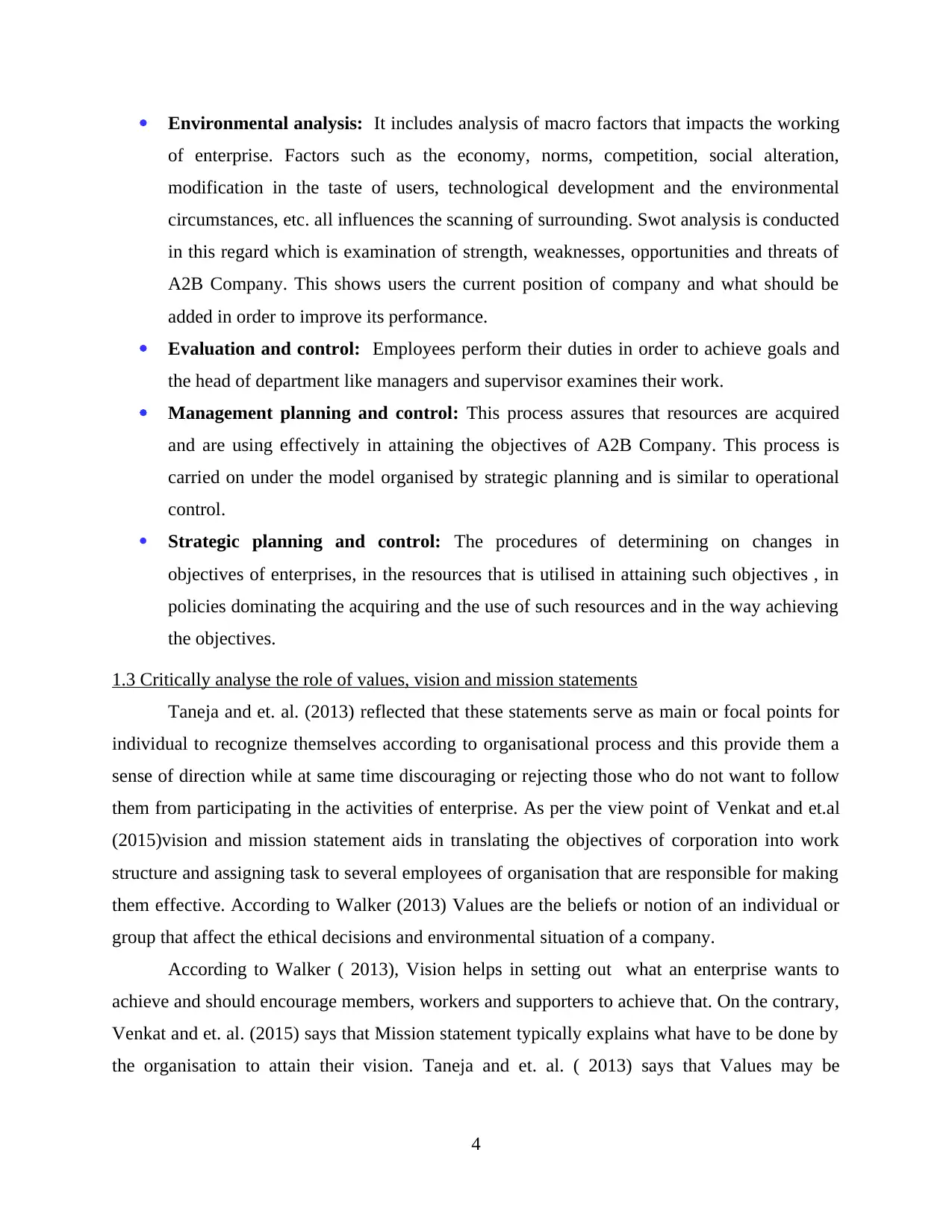
Environmental analysis: It includes analysis of macro factors that impacts the working
of enterprise. Factors such as the economy, norms, competition, social alteration,
modification in the taste of users, technological development and the environmental
circumstances, etc. all influences the scanning of surrounding. Swot analysis is conducted
in this regard which is examination of strength, weaknesses, opportunities and threats of
A2B Company. This shows users the current position of company and what should be
added in order to improve its performance.
Evaluation and control: Employees perform their duties in order to achieve goals and
the head of department like managers and supervisor examines their work.
Management planning and control: This process assures that resources are acquired
and are using effectively in attaining the objectives of A2B Company. This process is
carried on under the model organised by strategic planning and is similar to operational
control.
Strategic planning and control: The procedures of determining on changes in
objectives of enterprises, in the resources that is utilised in attaining such objectives , in
policies dominating the acquiring and the use of such resources and in the way achieving
the objectives.
1.3 Critically analyse the role of values, vision and mission statements
Taneja and et. al. (2013) reflected that these statements serve as main or focal points for
individual to recognize themselves according to organisational process and this provide them a
sense of direction while at same time discouraging or rejecting those who do not want to follow
them from participating in the activities of enterprise. As per the view point of Venkat and et.al
(2015)vision and mission statement aids in translating the objectives of corporation into work
structure and assigning task to several employees of organisation that are responsible for making
them effective. According to Walker (2013) Values are the beliefs or notion of an individual or
group that affect the ethical decisions and environmental situation of a company.
According to Walker ( 2013), Vision helps in setting out what an enterprise wants to
achieve and should encourage members, workers and supporters to achieve that. On the contrary,
Venkat and et. al. (2015) says that Mission statement typically explains what have to be done by
the organisation to attain their vision. Taneja and et. al. ( 2013) says that Values may be
4
of enterprise. Factors such as the economy, norms, competition, social alteration,
modification in the taste of users, technological development and the environmental
circumstances, etc. all influences the scanning of surrounding. Swot analysis is conducted
in this regard which is examination of strength, weaknesses, opportunities and threats of
A2B Company. This shows users the current position of company and what should be
added in order to improve its performance.
Evaluation and control: Employees perform their duties in order to achieve goals and
the head of department like managers and supervisor examines their work.
Management planning and control: This process assures that resources are acquired
and are using effectively in attaining the objectives of A2B Company. This process is
carried on under the model organised by strategic planning and is similar to operational
control.
Strategic planning and control: The procedures of determining on changes in
objectives of enterprises, in the resources that is utilised in attaining such objectives , in
policies dominating the acquiring and the use of such resources and in the way achieving
the objectives.
1.3 Critically analyse the role of values, vision and mission statements
Taneja and et. al. (2013) reflected that these statements serve as main or focal points for
individual to recognize themselves according to organisational process and this provide them a
sense of direction while at same time discouraging or rejecting those who do not want to follow
them from participating in the activities of enterprise. As per the view point of Venkat and et.al
(2015)vision and mission statement aids in translating the objectives of corporation into work
structure and assigning task to several employees of organisation that are responsible for making
them effective. According to Walker (2013) Values are the beliefs or notion of an individual or
group that affect the ethical decisions and environmental situation of a company.
According to Walker ( 2013), Vision helps in setting out what an enterprise wants to
achieve and should encourage members, workers and supporters to achieve that. On the contrary,
Venkat and et. al. (2015) says that Mission statement typically explains what have to be done by
the organisation to attain their vision. Taneja and et. al. ( 2013) says that Values may be
4
Paraphrase This Document
Need a fresh take? Get an instant paraphrase of this document with our AI Paraphraser
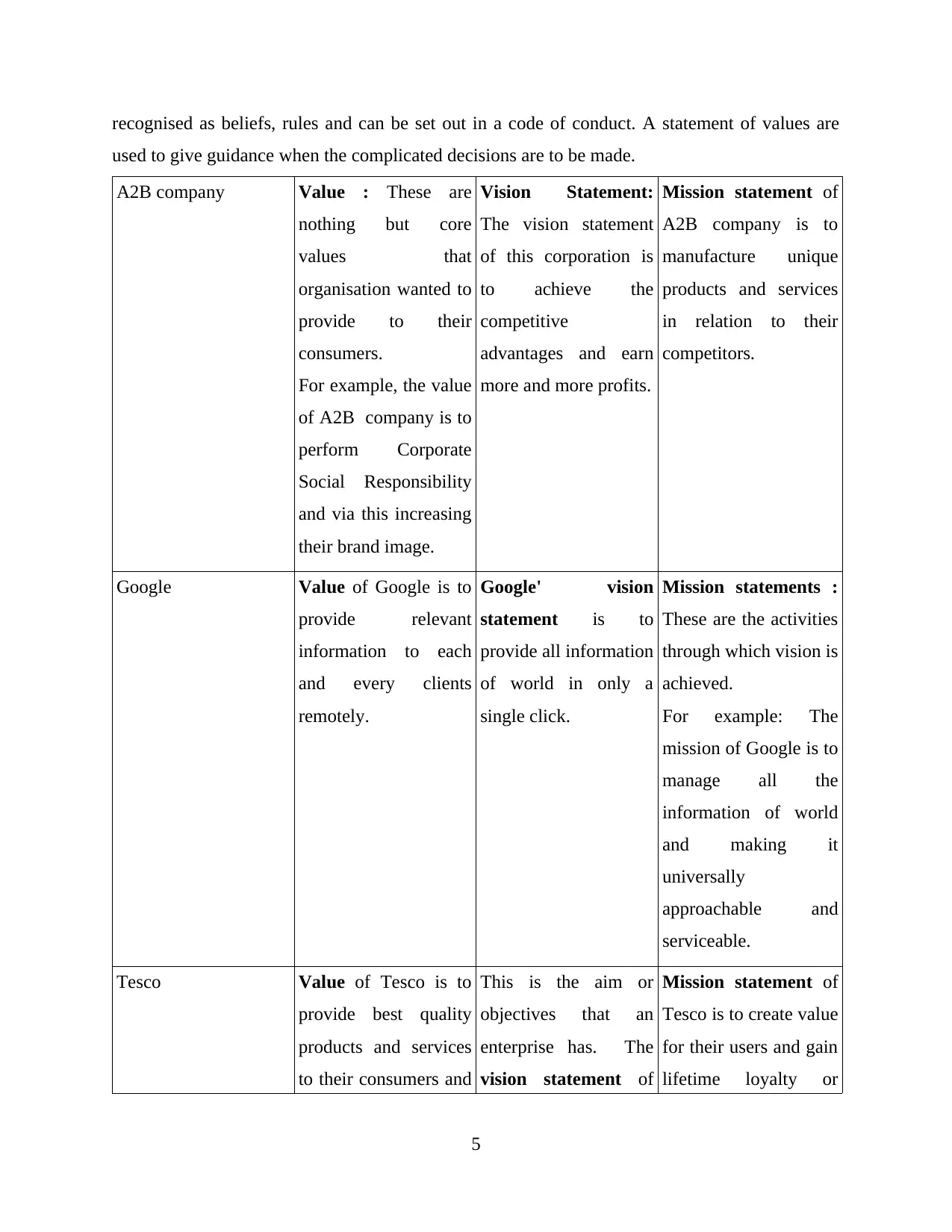
recognised as beliefs, rules and can be set out in a code of conduct. A statement of values are
used to give guidance when the complicated decisions are to be made.
A2B company Value : These are
nothing but core
values that
organisation wanted to
provide to their
consumers.
For example, the value
of A2B company is to
perform Corporate
Social Responsibility
and via this increasing
their brand image.
Vision Statement:
The vision statement
of this corporation is
to achieve the
competitive
advantages and earn
more and more profits.
Mission statement of
A2B company is to
manufacture unique
products and services
in relation to their
competitors.
Google Value of Google is to
provide relevant
information to each
and every clients
remotely.
Google' vision
statement is to
provide all information
of world in only a
single click.
Mission statements :
These are the activities
through which vision is
achieved.
For example: The
mission of Google is to
manage all the
information of world
and making it
universally
approachable and
serviceable.
Tesco Value of Tesco is to
provide best quality
products and services
to their consumers and
This is the aim or
objectives that an
enterprise has. The
vision statement of
Mission statement of
Tesco is to create value
for their users and gain
lifetime loyalty or
5
used to give guidance when the complicated decisions are to be made.
A2B company Value : These are
nothing but core
values that
organisation wanted to
provide to their
consumers.
For example, the value
of A2B company is to
perform Corporate
Social Responsibility
and via this increasing
their brand image.
Vision Statement:
The vision statement
of this corporation is
to achieve the
competitive
advantages and earn
more and more profits.
Mission statement of
A2B company is to
manufacture unique
products and services
in relation to their
competitors.
Google Value of Google is to
provide relevant
information to each
and every clients
remotely.
Google' vision
statement is to
provide all information
of world in only a
single click.
Mission statements :
These are the activities
through which vision is
achieved.
For example: The
mission of Google is to
manage all the
information of world
and making it
universally
approachable and
serviceable.
Tesco Value of Tesco is to
provide best quality
products and services
to their consumers and
This is the aim or
objectives that an
enterprise has. The
vision statement of
Mission statement of
Tesco is to create value
for their users and gain
lifetime loyalty or
5
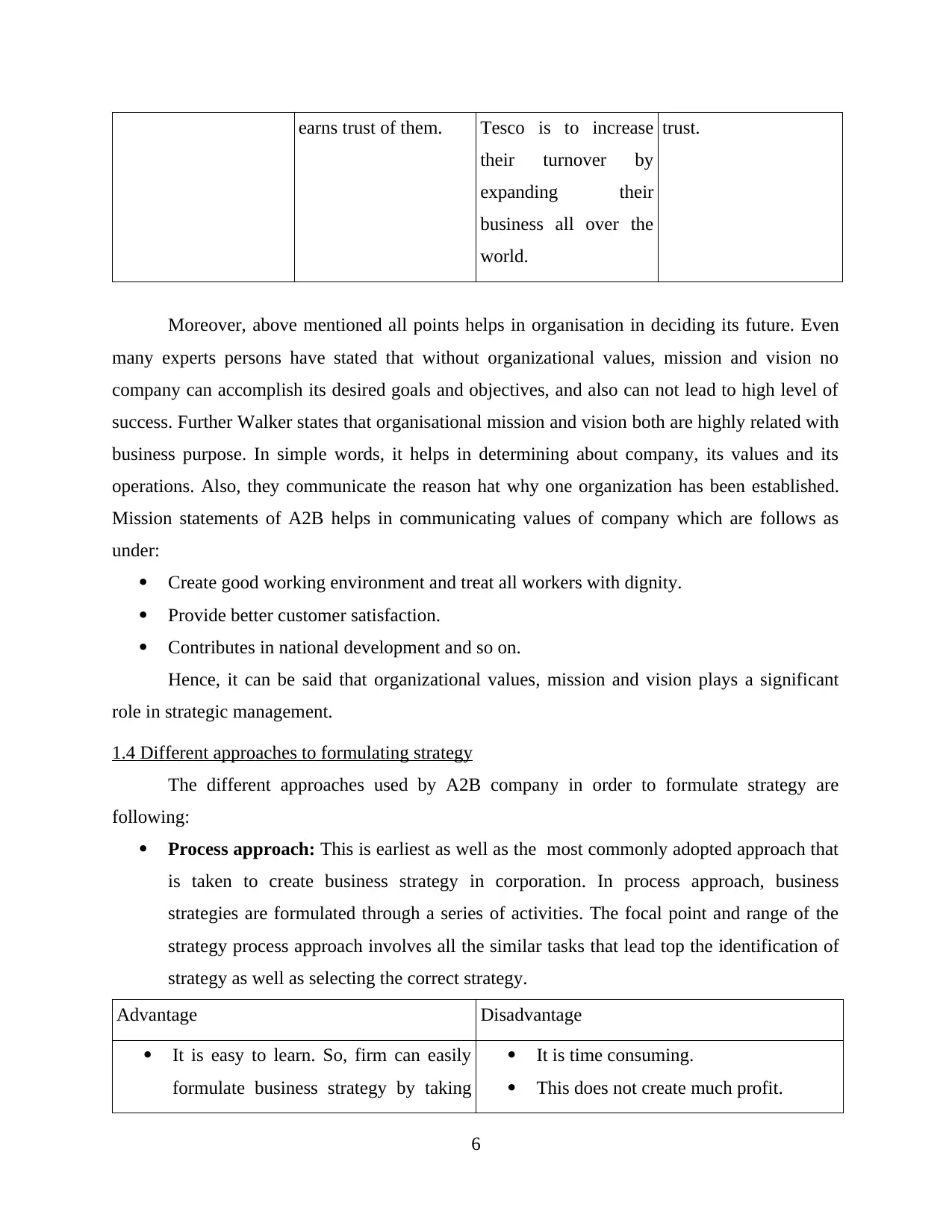
earns trust of them. Tesco is to increase
their turnover by
expanding their
business all over the
world.
trust.
Moreover, above mentioned all points helps in organisation in deciding its future. Even
many experts persons have stated that without organizational values, mission and vision no
company can accomplish its desired goals and objectives, and also can not lead to high level of
success. Further Walker states that organisational mission and vision both are highly related with
business purpose. In simple words, it helps in determining about company, its values and its
operations. Also, they communicate the reason hat why one organization has been established.
Mission statements of A2B helps in communicating values of company which are follows as
under:
Create good working environment and treat all workers with dignity.
Provide better customer satisfaction.
Contributes in national development and so on.
Hence, it can be said that organizational values, mission and vision plays a significant
role in strategic management.
1.4 Different approaches to formulating strategy
The different approaches used by A2B company in order to formulate strategy are
following:
Process approach: This is earliest as well as the most commonly adopted approach that
is taken to create business strategy in corporation. In process approach, business
strategies are formulated through a series of activities. The focal point and range of the
strategy process approach involves all the similar tasks that lead top the identification of
strategy as well as selecting the correct strategy.
Advantage Disadvantage
It is easy to learn. So, firm can easily
formulate business strategy by taking
It is time consuming.
This does not create much profit.
6
their turnover by
expanding their
business all over the
world.
trust.
Moreover, above mentioned all points helps in organisation in deciding its future. Even
many experts persons have stated that without organizational values, mission and vision no
company can accomplish its desired goals and objectives, and also can not lead to high level of
success. Further Walker states that organisational mission and vision both are highly related with
business purpose. In simple words, it helps in determining about company, its values and its
operations. Also, they communicate the reason hat why one organization has been established.
Mission statements of A2B helps in communicating values of company which are follows as
under:
Create good working environment and treat all workers with dignity.
Provide better customer satisfaction.
Contributes in national development and so on.
Hence, it can be said that organizational values, mission and vision plays a significant
role in strategic management.
1.4 Different approaches to formulating strategy
The different approaches used by A2B company in order to formulate strategy are
following:
Process approach: This is earliest as well as the most commonly adopted approach that
is taken to create business strategy in corporation. In process approach, business
strategies are formulated through a series of activities. The focal point and range of the
strategy process approach involves all the similar tasks that lead top the identification of
strategy as well as selecting the correct strategy.
Advantage Disadvantage
It is easy to learn. So, firm can easily
formulate business strategy by taking
It is time consuming.
This does not create much profit.
6
⊘ This is a preview!⊘
Do you want full access?
Subscribe today to unlock all pages.

Trusted by 1+ million students worldwide
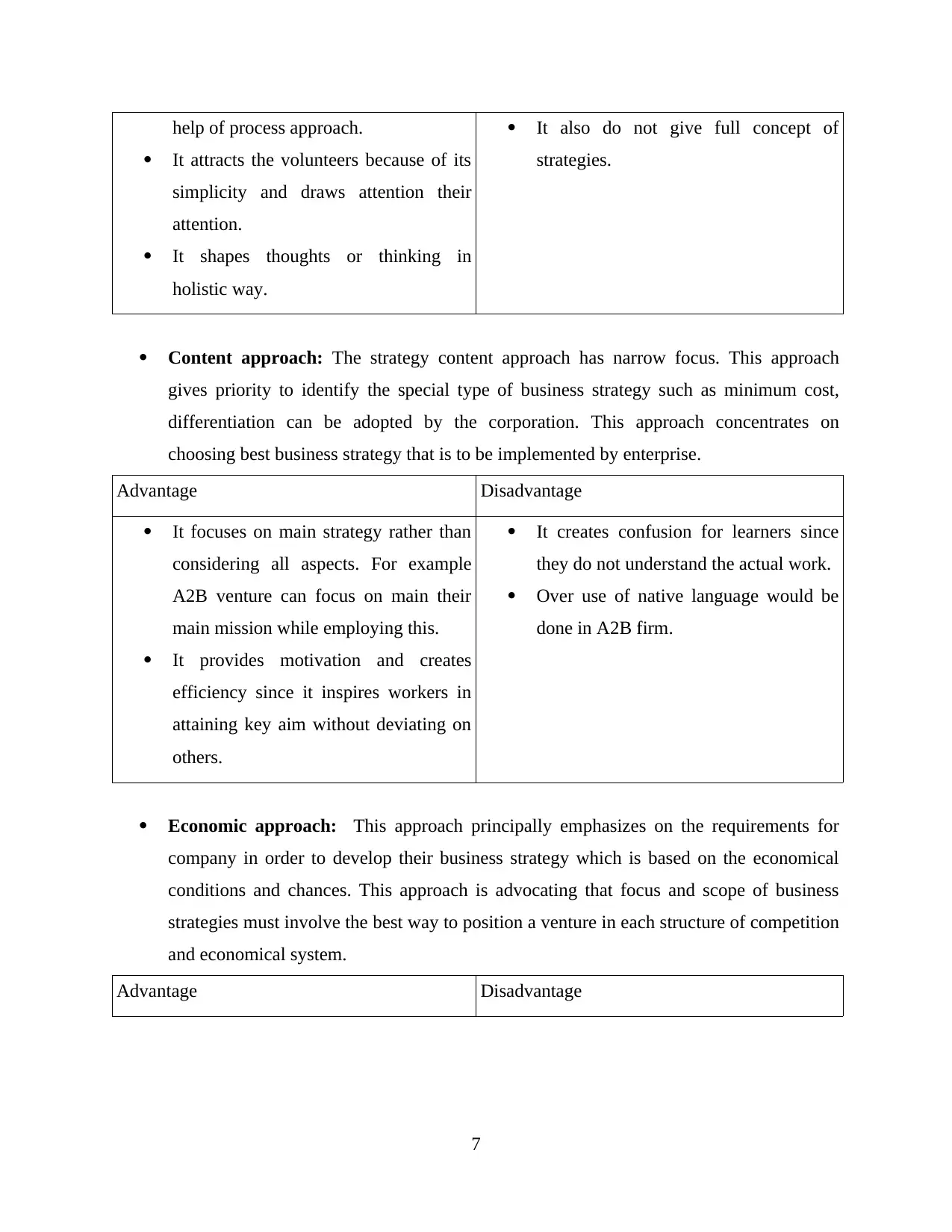
help of process approach.
It attracts the volunteers because of its
simplicity and draws attention their
attention.
It shapes thoughts or thinking in
holistic way.
It also do not give full concept of
strategies.
Content approach: The strategy content approach has narrow focus. This approach
gives priority to identify the special type of business strategy such as minimum cost,
differentiation can be adopted by the corporation. This approach concentrates on
choosing best business strategy that is to be implemented by enterprise.
Advantage Disadvantage
It focuses on main strategy rather than
considering all aspects. For example
A2B venture can focus on main their
main mission while employing this.
It provides motivation and creates
efficiency since it inspires workers in
attaining key aim without deviating on
others.
It creates confusion for learners since
they do not understand the actual work.
Over use of native language would be
done in A2B firm.
Economic approach: This approach principally emphasizes on the requirements for
company in order to develop their business strategy which is based on the economical
conditions and chances. This approach is advocating that focus and scope of business
strategies must involve the best way to position a venture in each structure of competition
and economical system.
Advantage Disadvantage
7
It attracts the volunteers because of its
simplicity and draws attention their
attention.
It shapes thoughts or thinking in
holistic way.
It also do not give full concept of
strategies.
Content approach: The strategy content approach has narrow focus. This approach
gives priority to identify the special type of business strategy such as minimum cost,
differentiation can be adopted by the corporation. This approach concentrates on
choosing best business strategy that is to be implemented by enterprise.
Advantage Disadvantage
It focuses on main strategy rather than
considering all aspects. For example
A2B venture can focus on main their
main mission while employing this.
It provides motivation and creates
efficiency since it inspires workers in
attaining key aim without deviating on
others.
It creates confusion for learners since
they do not understand the actual work.
Over use of native language would be
done in A2B firm.
Economic approach: This approach principally emphasizes on the requirements for
company in order to develop their business strategy which is based on the economical
conditions and chances. This approach is advocating that focus and scope of business
strategies must involve the best way to position a venture in each structure of competition
and economical system.
Advantage Disadvantage
7
Paraphrase This Document
Need a fresh take? Get an instant paraphrase of this document with our AI Paraphraser
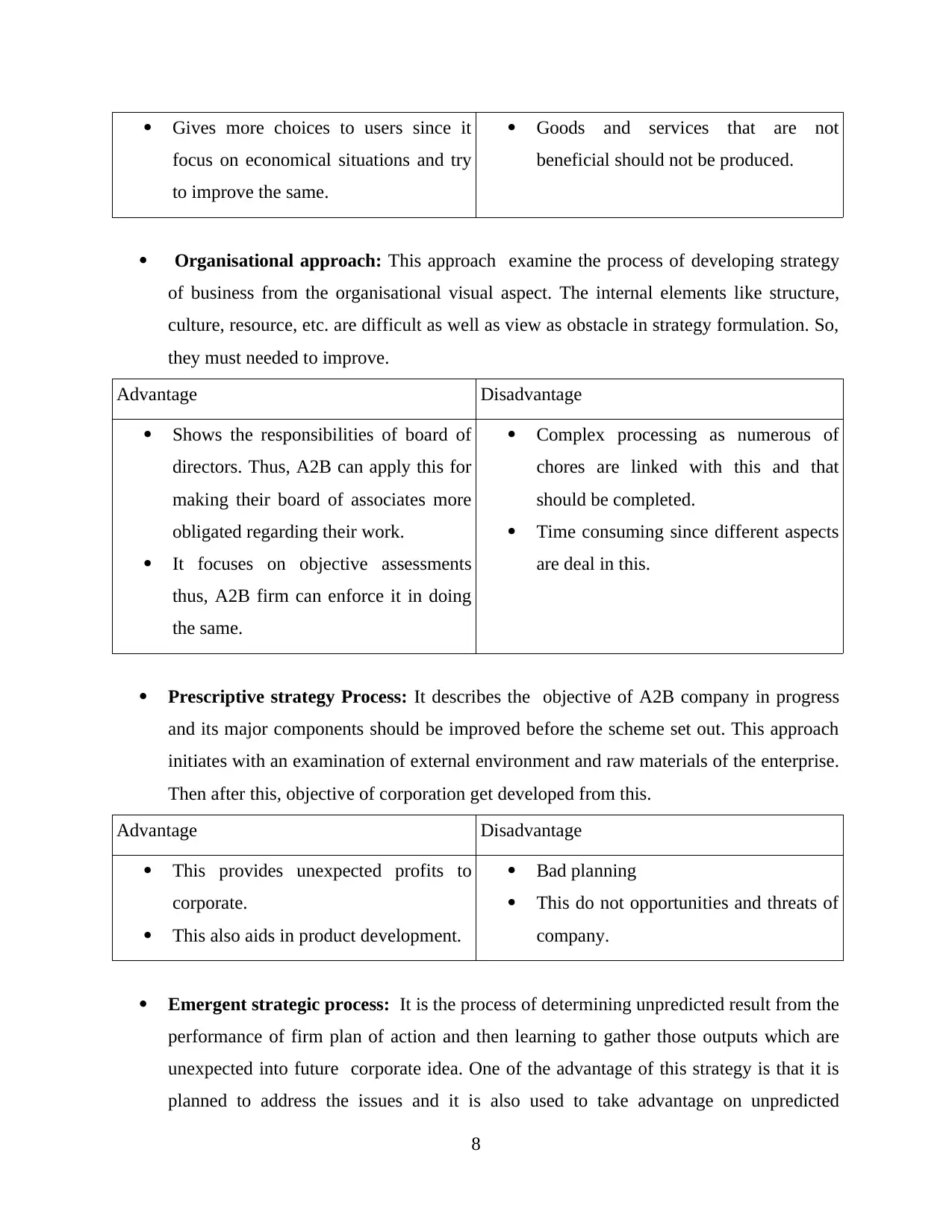
Gives more choices to users since it
focus on economical situations and try
to improve the same.
Goods and services that are not
beneficial should not be produced.
Organisational approach: This approach examine the process of developing strategy
of business from the organisational visual aspect. The internal elements like structure,
culture, resource, etc. are difficult as well as view as obstacle in strategy formulation. So,
they must needed to improve.
Advantage Disadvantage
Shows the responsibilities of board of
directors. Thus, A2B can apply this for
making their board of associates more
obligated regarding their work.
It focuses on objective assessments
thus, A2B firm can enforce it in doing
the same.
Complex processing as numerous of
chores are linked with this and that
should be completed.
Time consuming since different aspects
are deal in this.
Prescriptive strategy Process: It describes the objective of A2B company in progress
and its major components should be improved before the scheme set out. This approach
initiates with an examination of external environment and raw materials of the enterprise.
Then after this, objective of corporation get developed from this.
Advantage Disadvantage
This provides unexpected profits to
corporate.
This also aids in product development.
Bad planning
This do not opportunities and threats of
company.
Emergent strategic process: It is the process of determining unpredicted result from the
performance of firm plan of action and then learning to gather those outputs which are
unexpected into future corporate idea. One of the advantage of this strategy is that it is
planned to address the issues and it is also used to take advantage on unpredicted
8
focus on economical situations and try
to improve the same.
Goods and services that are not
beneficial should not be produced.
Organisational approach: This approach examine the process of developing strategy
of business from the organisational visual aspect. The internal elements like structure,
culture, resource, etc. are difficult as well as view as obstacle in strategy formulation. So,
they must needed to improve.
Advantage Disadvantage
Shows the responsibilities of board of
directors. Thus, A2B can apply this for
making their board of associates more
obligated regarding their work.
It focuses on objective assessments
thus, A2B firm can enforce it in doing
the same.
Complex processing as numerous of
chores are linked with this and that
should be completed.
Time consuming since different aspects
are deal in this.
Prescriptive strategy Process: It describes the objective of A2B company in progress
and its major components should be improved before the scheme set out. This approach
initiates with an examination of external environment and raw materials of the enterprise.
Then after this, objective of corporation get developed from this.
Advantage Disadvantage
This provides unexpected profits to
corporate.
This also aids in product development.
Bad planning
This do not opportunities and threats of
company.
Emergent strategic process: It is the process of determining unpredicted result from the
performance of firm plan of action and then learning to gather those outputs which are
unexpected into future corporate idea. One of the advantage of this strategy is that it is
planned to address the issues and it is also used to take advantage on unpredicted
8
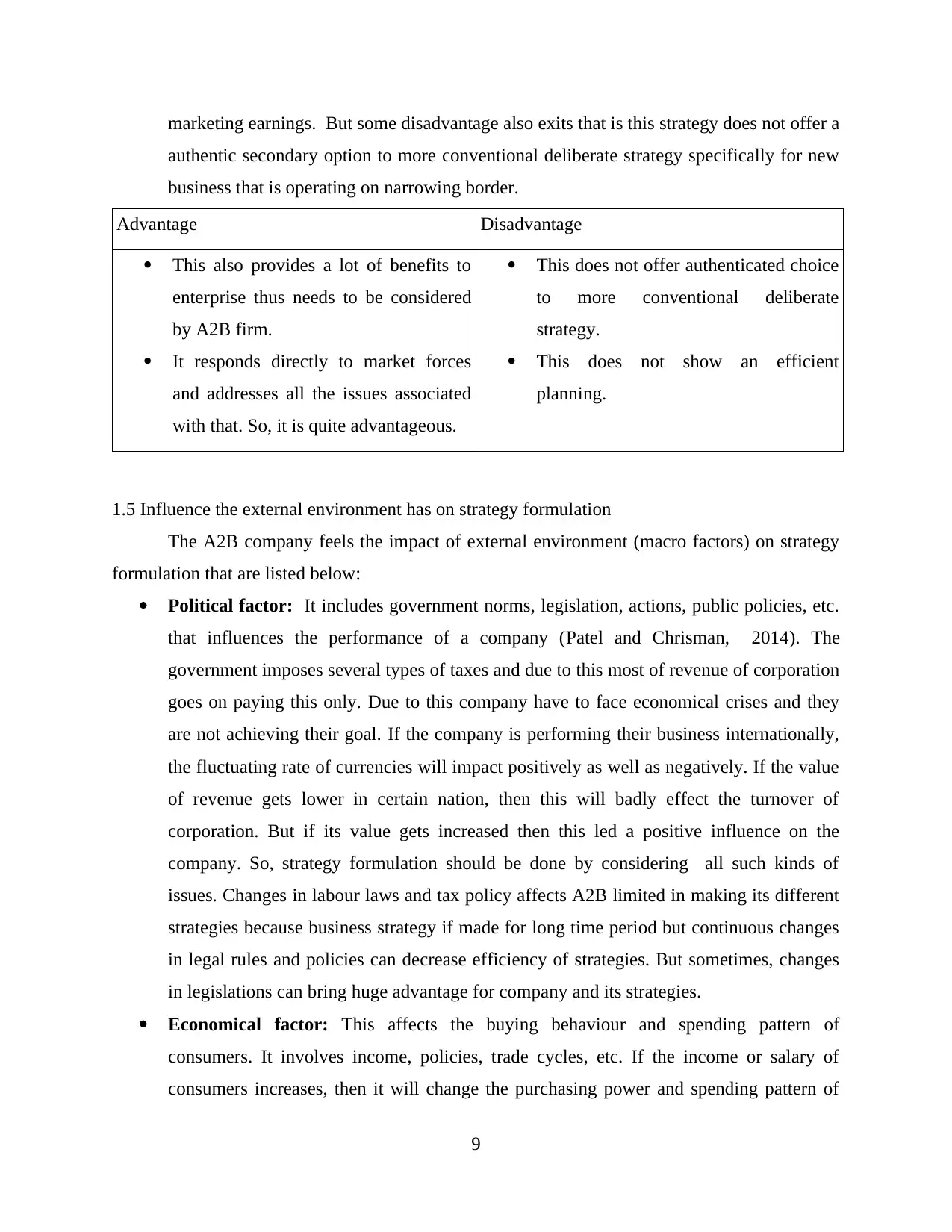
marketing earnings. But some disadvantage also exits that is this strategy does not offer a
authentic secondary option to more conventional deliberate strategy specifically for new
business that is operating on narrowing border.
Advantage Disadvantage
This also provides a lot of benefits to
enterprise thus needs to be considered
by A2B firm.
It responds directly to market forces
and addresses all the issues associated
with that. So, it is quite advantageous.
This does not offer authenticated choice
to more conventional deliberate
strategy.
This does not show an efficient
planning.
1.5 Influence the external environment has on strategy formulation
The A2B company feels the impact of external environment (macro factors) on strategy
formulation that are listed below:
Political factor: It includes government norms, legislation, actions, public policies, etc.
that influences the performance of a company (Patel and Chrisman, 2014). The
government imposes several types of taxes and due to this most of revenue of corporation
goes on paying this only. Due to this company have to face economical crises and they
are not achieving their goal. If the company is performing their business internationally,
the fluctuating rate of currencies will impact positively as well as negatively. If the value
of revenue gets lower in certain nation, then this will badly effect the turnover of
corporation. But if its value gets increased then this led a positive influence on the
company. So, strategy formulation should be done by considering all such kinds of
issues. Changes in labour laws and tax policy affects A2B limited in making its different
strategies because business strategy if made for long time period but continuous changes
in legal rules and policies can decrease efficiency of strategies. But sometimes, changes
in legislations can bring huge advantage for company and its strategies.
Economical factor: This affects the buying behaviour and spending pattern of
consumers. It involves income, policies, trade cycles, etc. If the income or salary of
consumers increases, then it will change the purchasing power and spending pattern of
9
authentic secondary option to more conventional deliberate strategy specifically for new
business that is operating on narrowing border.
Advantage Disadvantage
This also provides a lot of benefits to
enterprise thus needs to be considered
by A2B firm.
It responds directly to market forces
and addresses all the issues associated
with that. So, it is quite advantageous.
This does not offer authenticated choice
to more conventional deliberate
strategy.
This does not show an efficient
planning.
1.5 Influence the external environment has on strategy formulation
The A2B company feels the impact of external environment (macro factors) on strategy
formulation that are listed below:
Political factor: It includes government norms, legislation, actions, public policies, etc.
that influences the performance of a company (Patel and Chrisman, 2014). The
government imposes several types of taxes and due to this most of revenue of corporation
goes on paying this only. Due to this company have to face economical crises and they
are not achieving their goal. If the company is performing their business internationally,
the fluctuating rate of currencies will impact positively as well as negatively. If the value
of revenue gets lower in certain nation, then this will badly effect the turnover of
corporation. But if its value gets increased then this led a positive influence on the
company. So, strategy formulation should be done by considering all such kinds of
issues. Changes in labour laws and tax policy affects A2B limited in making its different
strategies because business strategy if made for long time period but continuous changes
in legal rules and policies can decrease efficiency of strategies. But sometimes, changes
in legislations can bring huge advantage for company and its strategies.
Economical factor: This affects the buying behaviour and spending pattern of
consumers. It involves income, policies, trade cycles, etc. If the income or salary of
consumers increases, then it will change the purchasing power and spending pattern of
9
⊘ This is a preview!⊘
Do you want full access?
Subscribe today to unlock all pages.

Trusted by 1+ million students worldwide
1 out of 34
Related Documents
Your All-in-One AI-Powered Toolkit for Academic Success.
+13062052269
info@desklib.com
Available 24*7 on WhatsApp / Email
![[object Object]](/_next/static/media/star-bottom.7253800d.svg)
Unlock your academic potential
Copyright © 2020–2025 A2Z Services. All Rights Reserved. Developed and managed by ZUCOL.





